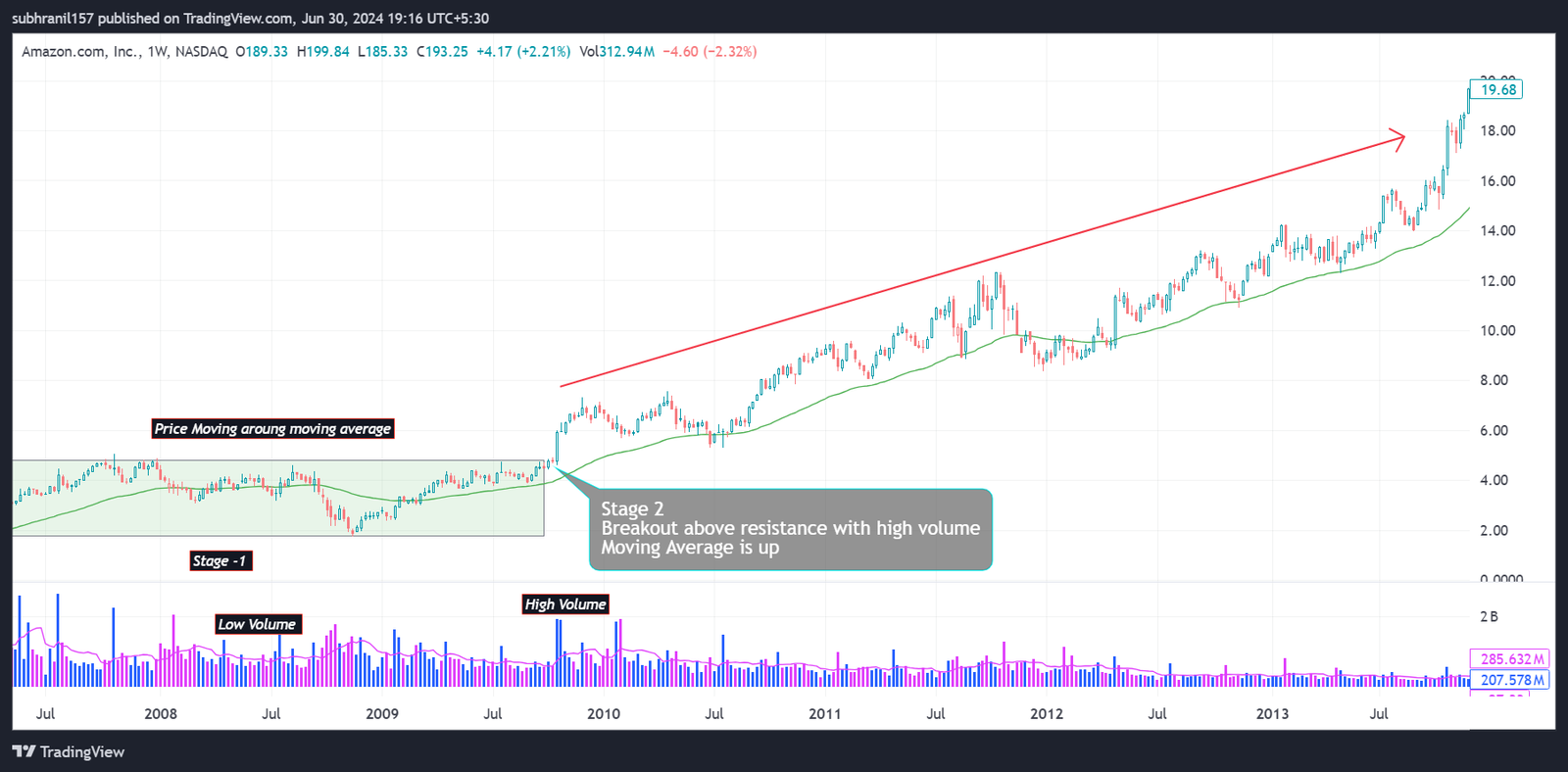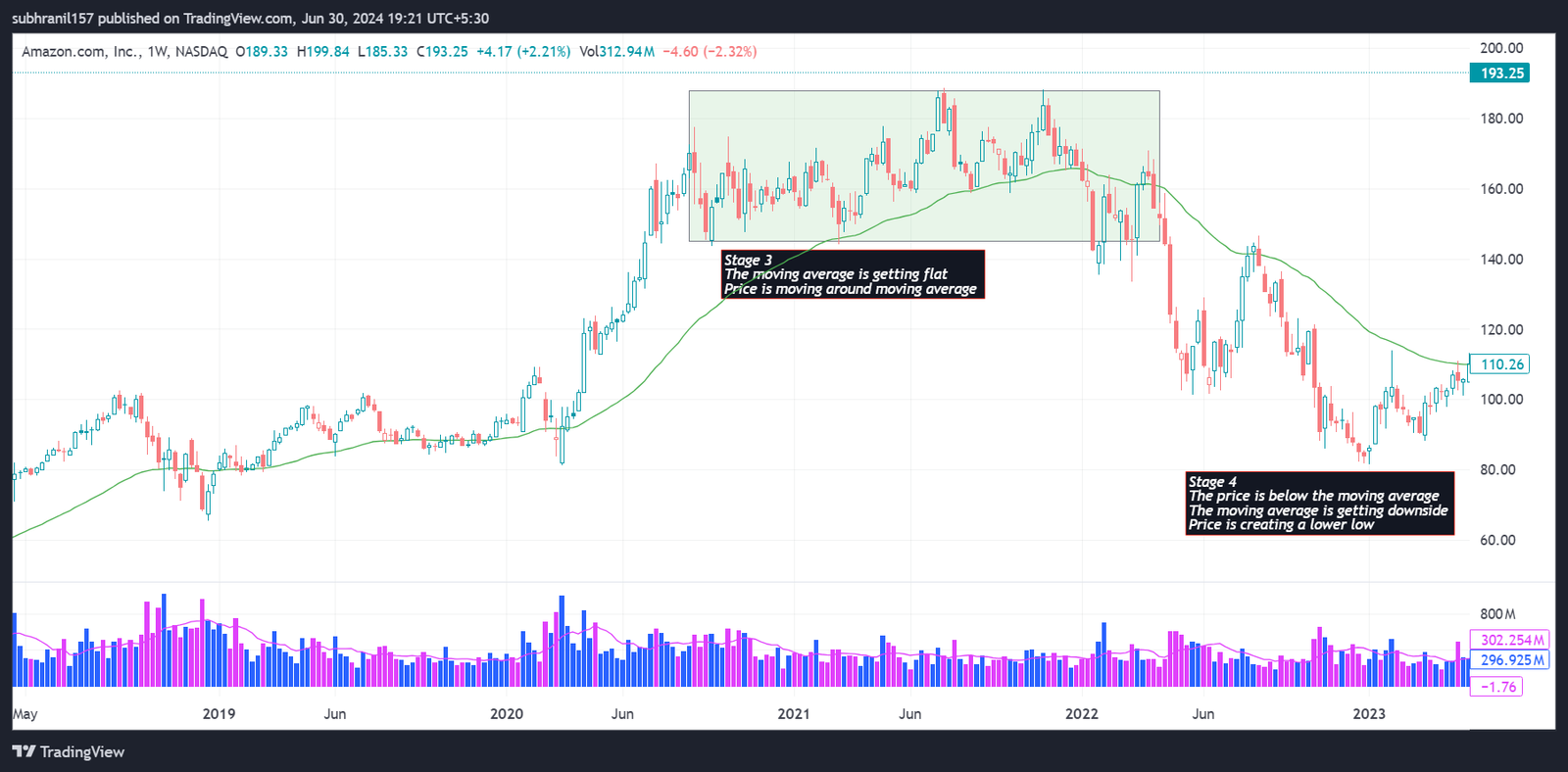Introduction:
Stock market investing is frequently compared to navigating a changing landscape, where your comprehension of the terrain greatly influences success. Determining the Stage of the Stock is a crucial component of this environment. Equities also go through unique stages that can affect performance and risk profile, much like a firm does as it grows and matures. These phases span from early growth to maturity and possible decline, providing insightful information that helps investors make wise choices.
Comprehending a stock’s stage necessitates a comprehensive examination that incorporates financial indicators, market attitude, and wider economic circumstances. Although early-stage stocks have higher risk and volatility, they frequently have strong growth potential. Mature stocks, on the other hand, might have limited growth potential but might offer stability and consistent dividends. Investors can better match their strategies with their financial goals by knowing where a stock is in its lifecycle. This helps them take advantage of high-growth opportunities and secure reliable income streams.
We will examine the many phases of a stock, its attributes, and the instruments and signals that can assist you in ascertaining a stock’s present value in this tutorial. Gaining mastery over this information can help you improve the performance of your investing portfolio and better navigate the intricacies of the stock market.
Stage 1 – Base Area / Accumulation Phase
In the stock market, the accumulation phase is a crucial time in all Stages of the Stock, when astute investors begin to increase their holdings in a stock that has had a substantial decline or an extended spell of inactivity. Acknowledging this stage can present profitable chances for investors to purchase stock before it perhaps starts a significant upward trend. The accumulation phase is characterized by the following particular symptoms:
- Less volume at base formation – When stock is in the accumulation phase, volumes are on the lower side.
- Price remains rangebound – Price remains rangebound in the accumulation phase.
- The moving average loses its downside slope and starts to flatten- when the stock is accumulation phase moving average like 50 MA or 30 MA loses its angle from downside to flat. It means sellers are getting weak and bulls are taking interest in this stock and its downside is limited.
- Stocks move around moving some sometimes above and sometimes down – In the accumulation stage, stock moves around the moving average, sometimes it is above the moving average some sometimes it is downside. Like sine wave.
- The price moved between the support and resistance area – As described, stock remains rangebound means within in support and resistance area.
Stage 2 – Advance Area / Markup Phase
The advance phase, sometimes referred to as the markup phase, is defined by a discernible upward trend in the price of the stock. In all Stages of the Stock, this stage can provide investors with considerable profit potential and frequently comes after the accumulation phase. Identifying the signs of the advance phase can assist investors in taking prompt action to optimize profits. The following particulars are distinctive to the advanced phase:
- A breakout above the resistance zone and 30 MA with impressive volume – In the Markup area stocks break out from the resistance area with high volume.
- Moving Average moving up – In this Markup Phase moving average is getting positive and moving high from a flat position.
- Fundamentals are starting to improve – When the stocks are in the markup phase, it has been shown that stock fundamentals are improving. In terms of earnings, Business expansion, Profit margin and PE start improving in this phase.
- Higher high – In this markup phase, the stock is making a higher high.
Stage 3 – Top Area / Distribution Phase
A stock enters the distribution phase, sometimes referred to as the markdown phase, when it moves from an upward trend to a period of consolidation or decrease. In all Stages of the Stock, this phase, which frequently comes after the advance phase, is marked by a lot of selling when investors—especially big institutions—start realizing profits. Investors must recognize the signs of the distribution phase to safeguard their profits and prevent future losses. The dissemination phase is characterized by the following particular details:
- High volume in stage 3 with sharp moves and choppy – In the distribution phase, it has been observed that high-volume bars appear on top of the curve.
- Moving average loses its uptrend slope and flattens out – In the distribution phase, the moving average is getting flatter from the upside direction.
- Stocks are tiptoe below and above 30 MA – Stocks are moving around the moving average. Sometimes stocks are prepared to support and resistance zone means range bound.
- Good news is coming and stocks are overvalued – It has been observed that, in the distribution phase, stocks are looking highly valued and good news is coming out.
Stage 4 – Declining Phase / Markdown Phase
Stock prices experience a prolonged period of decrease following a high. This is known as the decline phase. Usually occurring after the distribution phase, unprepared investors may suffer large losses during this period. Investors must be aware of the signs of the fall phase to safeguard their money and take advantage of possible shorting chances. The following particulars are distinctive to the decline phase:
- Stocks break support zone – In the Markdown phase, stocks break down from the support zone. The price moved below the moving average and the distance between the moving average and the price is getting greater.
- Breakdown below the support zone does not require a higher volume to confirm the breakout. But if the breakout is with a higher volume, it is a very dangerous situation.
- Lower Low – In the markdown phase, the stock is preparing a lower low.
- Moving Average is a downside- In the Markdown phase, the moving average moves downside from flat.
FAQ:
Q: How can I determine if a stock is in the accumulation phase?
A:
- Less volume at base formation
- Price remains rangebound
- The moving average loses its downside slope and starts to flatten
- Stocks move around moving average some sometimes above and sometimes down
- The price moved between the support and resistance area
Q: What are the key indicators of the advance phase in stocks?
A: The moving average is moving up and the price is above the moving average for a longer period.
Q: What are the symptoms of a stock entering the decline phase?
A: The moving average is going down and the price is below the moving average. And the price is forming a lower low.
Q: Is it possible to profit from identifying the stages of a stock?
A: Yes, there are prospects for profit when one understands and correctly recognizes the stages of a stock. Investing methods can be matched to the current stage, which might be growth, income, or capital preservation, allowing investors to maximize portfolio performance and meet their financial goals.
Conclusion:
Investors can match the direction of the stock and the current market conditions with their decisions by learning to recognize these stages. This knowledge makes it possible to choose wise points of entry and departure, increasing profit potential and lowering exposure to possible losses.
Furthermore, identifying a stock’s stages necessitates a comprehensive strategy that incorporates fundamental research, market sentiment analysis, and knowledge of wider economic trends in addition to technical analysis. Profitable investors make use of these insights to adjust their strategies in real-time, taking advantage of the opportunities that each stage presents while reducing the risks brought on by cyclical swings and market volatility.
In the end, knowing a stock’s phases enables investors to make choices that are in line with their financial objectives and risk tolerance.
Stage Analysis


Very interesting subject, appreciate it for putting up.Leadership
Really fantastic information can be found on web blog.Raise range
Write more, thats all I have to say. Literally, it seems as though you relied on the video to make your point.
You clearly know what youre talking about, why waste your intelligence on just posting videos to your
blog when you could be giving us something enlightening to read?
Howdy! I could have sworn I’ve been to this website before but after
looking at many of the posts I realized it’s new
to me. Anyways, I’m definitely pleased I found it and I’ll be book-marking it and checking back often!
Good way of explaining, and fastidious paragraph to obtain facts concerning my presentation topic, which i am going to
convey in college.
Just desire to say your article is as surprising.
The clearness for your put up is simply nice and i can think you’re knowledgeable on this subject.
Well along with your permission allow me to grasp your RSS feed
to stay updated with approaching post. Thank you 1,000,000 and please
continue the gratifying work.
Hello. . nw.dn.ua
nw.dn.ua
https://nw.dn.ua zwz4763574
Hello! I hope you’re having a great day. Good luck 🙂
That is very fascinating, You’re an overly professional blogger. I’ve joined your feed and look forward to searching for extra of your fantastic post. Additionally, I have shared your web site in my social networks
hafilat online services